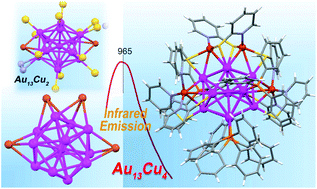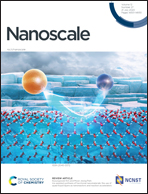Ligand accommodation causes the anti-centrosymmetric structure of Au13Cu4 clusters with near-infrared emission†
Abstract
We synthesized an [Au13Cu4(PPh3)4(SPy)8]+ nanocluster co-capped by phosphine and thiolate ligands. Interestingly, this Au13Cu4 cluster corresponds to an anti-centrosymmetric structure with the four copper atoms coordinated to the mixed ligands on the same side of the Au13 icosahedron, which is in sharp contrast to the [Au13Cu4(PPh2Py)4(SPhtBu)8]+ and [Au13Cu2(PPh3)6(SPy)6]+ clusters which possess highly symmetric structures with well-separated Cu adatoms. Both [Au13Cu4(PPh3)4(SPy)8]+ and [Au13Cu2(PPh3)6(SPy)6]+ clusters correspond to 8 valence electron superatoms with large HOMO–LUMO gaps, respectively. The difference in structure is rooted in the nature of the mixed ligands, with the bidentate SPy binding strongly to Cu on both binding sites (–N–Cu and Au-SR-Cu) leading to the co-linking of adjacent Cu atoms, while the bidentate PPh2Py binds Cu on one site and Au on the other giving rise to a separation of the Cu atoms even in the presence of relatively higher monomer concentration. Both [Au13Cu4(PPh3)4(SPy)8]+ and [Au13Cu2(PPh3)6(SPy)6]+ display emissions in the near-IR regions. TD-DFT calculations reproduce the spectroscopic results with specified excited states, shedding light on the geometric and electronic behaviors of the ligand-protected Au13Mx clusters.



 Please wait while we load your content...
Please wait while we load your content...